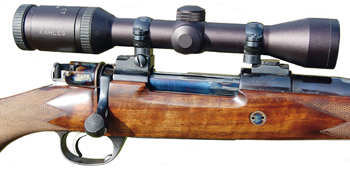Gun reviews: W.J. Jeffery .270 rifle

Gun reviews: W.J. Jeffery .270 rifle
Gun reviews: W.J. Jeffery .270 rifle.
Here we have a Mauser-actioned, British stalking rifle built by Paul Roberts of W.J. Jeffery & Co.
The test gun is a well-proportioned .270 equipped with a Kahles 2-7x36mm variable scope on Redfield patent mounts, one of the best options for a permanently attached optic.
It weighs in at a very sensible 7lb 14oz. (8lb loaded), and bears a price tag of £4,500.
First impressions are of an especially elegant sporting gun, where the bespoke rifle scores over the mass-produced machine with outstanding ‘London’ quality of finish.
Looking at the specification in more detail, the 24″ barrel – made by Lother Walther – is of medium taper. It has a 1 in 11 twist, ideal for 130-150 grain range bullets. It carries no iron sights, but is equipped with a barrel band for a quick-detachable sling.
This is a much better looking arrangement than the more common stud on the fore-stock. It is more practical too, as it allows for better balance when the rifle is carried slung. Moreover, it especially suits a sound-moderated gun, and is less likely to pull out than a fore-stock stud, hence the near-universal use of a barrel band on heavy safari rifles.
The stock comb is only slightly inclined to the bore axis to reduce felt recoil, and has a restrained cheek piece. There
is a single recoil bar forward.
The grip is well radiused and a good size. It is not too small, as is sometimes the case on London rifles. The finish of the stock is as one would expect from a London gunmaker – traditional oil and expert hand-cut checkering.
The barrel is not free-floating, thus the barrel channel is less prone to the ingress of moisture and foreign bodies, though free-floating is a house option. There is a thin brown recoil pad, which is practical and does not cause glitches as the gun is mounted.
The action is a German-sourced ‘Argentinian contract’ Oberndorf Mauser. Originally made for the Argentinean army, these are generally considered the ultimate base for a classic sporting rifle, though some high-tech productions in US may now give them a run for their money, and the pre-64 Winchester action is also much admired by rifle aficionados.
The specific advantage of the Oberndorf Mausers, as used by Holland & Holland and James Purdey, as well as W.J. Jeffery, is that their heat-treatment is especially good. So good, in fact, that it cannot be bettered today.
Mechanically, the action, which was designed by Paul Mauser in the late 19th century has some very important features.
First, it is strong and safe, with double front lugs and an extra safety lug to the rear. It also has a so-called ‘controlled feed’ and very positive extraction thanks to a long spring steel extractor that takes a much larger than average bite on the case rim. Ejection is by means of an action mounted blade that ‘cuts’ into the bolt head.
One can make actions that will provide better bench-rest accuracy, but none that can be relied upon more in extremis.
The Mauser – the first choice for dangerous game bolt rifles as well London made stalking rifles – will continue to feed in the most difficult circumstances. It will work, for example, upside down.
The Jeffery is equipped with a three position Winchester pre-64 style safety imported from Germany as well, but made to Paul’s specification. Interestingly, he also notes the possibility of equipping the rifle with a left-handed safety.
These he imports from the US, again to his specification. They have the advantage that they can be used by a right-hander without removing the rear hand from the grip.
Paul, who was formerly the chairman of Rigby, during which office he held the Royal Warrant as HM the Queen’s rifle maker, is one of the world’s most experienced hunters. The expert’s expert, there is little he does not know about rifle making. He has shot more big game and boar than anyone else alive in Britain. His stalking experience is no less extensive and his home in west Sussex is decorated with hundreds of trophies (many of roe deer).
Paul has made it his life?s work to perfect the modern hunting rifle. He has, however, proceeded on traditional lines, basing his modern production on the classic rifles of the 1920s and 1930s, but with some subtle, but important changes.
SHOOTING IMPRESSIONS
On the rifle range at the West London Shooting grounds the Jeffery proved no disappointment.
It shot with excellent accuracy, shooting well within 1″ at 100 yards.
Felt recoil was much better than average for a .270, which I would put down to good stock design, sensible weight, and particular attention having been paid to head-spacing. I also had a chance to test Paul’s own, very similar but more highly decorated .270; it’s handling characteristics and accuracy were almost identical.
For me, this just confirmed the consistency of product that Jeffery’s are producing.
The test Jeffery is a very fine rifle by any standard. It is beautiful and it is accurate. It points like a shotgun. It offers good value for money.
It also allows one to stalk with a gun of traditional appearance and be at no disadvantage to the utilitarian synthetic stocked creations that have become so popular in recent years. In simple terms, it’s a gentleman’s gun made by a gentleman of the old school.
I need hardly add that you might order one in any calibre you prefer, although it is ideally suited to .270, 30-06, 7×57 and 6.5×55.
PRICE:
£4,500
Gun reviews: W.J. Jeffery .270 rifle








